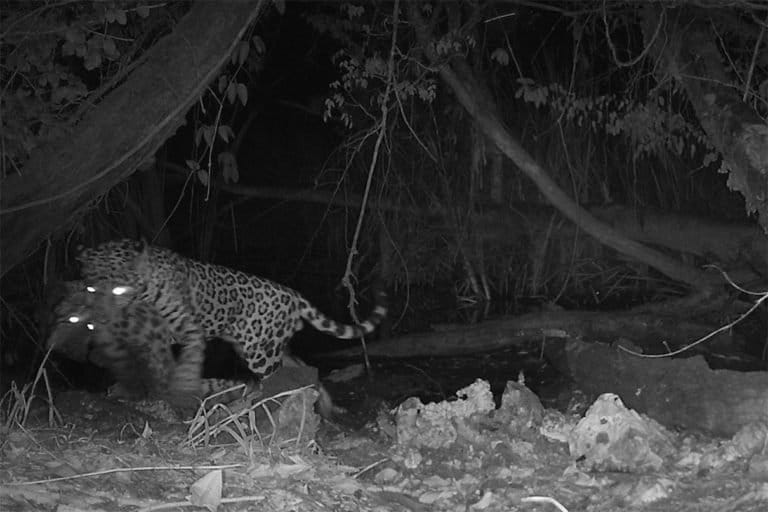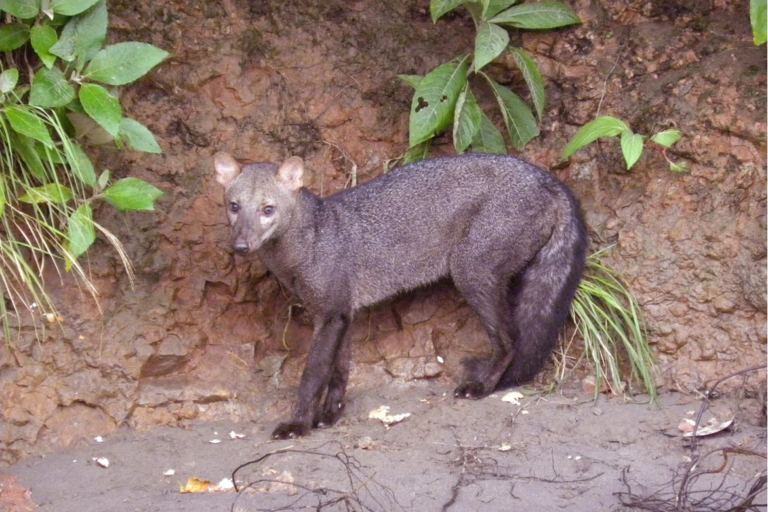Imagine you’re leading an expedition in the depths of a forest. You discover a species of frog that piques your interest. Conventional rules of taxonomy dictate that you capture the…
Camera traps are helping researchers get a closer look at pockets of Gabon’s forests that were previously impractical to study. The Central African country has, at 80% by some estimates,…
During what scientists have named the “Sixth Mass Extinction” (the fifth one wiped out the dinosaurs), conservationists are racing against the clock to carry out critical monitoring as quickly as…
After she collected a set of camera traps from the ridgeline above Corcovado National Park, conservation biologist Eleanor Flatt said that scientists, staff, and tourists all huddled around her computer…
A camera trap in Argentina’s Iberá National Park has revealed rare images of one of the world’s most elusive species: the maned wolf (Chrysocyon brachyurus). A series of clips shows…
There was a time when tiger expert Dale Miquelle wasn’t sure if there’d ever be a substantial population of Amur tigers (Panthera tigris altaica) in China again. In the 1990s,…
When Demian Chapman and his colleague first started setting up underwater cameras on reefs in 2015, the aim was to capture a lot of shark video. But sometimes they got…
An ocelot, a spotted and striped carnivore twice the size of a house cat, had just stopped at a water hole for a drink. But something was waiting for him:…
In 2016, conservation biologist Holly O’Donnell was striding through the Amazon rainforest in southwestern Peru, recording every mammal she saw or heard while performing a line transect survey for the…
On Sept. 15, Aleksandr Rybin was checking a camera trap in Russia’s Sikhote-Alin Biosphere Reserve when something red and long-tailed darted in the bushes in front of him. “A thought…
There are only about 300 Cross River gorillas left in the world, making them the rarest subspecies of gorilla, or indeed any great ape. But in late June, a camera…
When conservationists set up treetop cameras in Côte d’Ivoire’s Tanoé-Ehy forest, they hoped to get video of the elusive Miss Waldron’s red colobus monkey (Piliocolobus waldroni), a critically endangered species…
Conservationists set up two camera traps near a watering hole in a Thai forest — and then they waited. The first animal to step in front of the lens was…
Camera traps bring you closer to the secretive natural world and are an important conservation tool to study wildlife. This week we’re meeting the largest carnivorous marsupial in the world:…
Camera traps bring you closer to the secretive natural world and are an important conservation tool to study wildlife. This week we’re meeting an elusive wild cat: the jaguarundi. The…
The brown bear (Ursus arctos) is the most widespread species of bear ranging from North America to Europe and Asia. Due to this, they live in all sorts of habitats:…
Camera traps bring you closer to the secretive natural world and are an important conservation tool to study wildlife. This week we’re meeting the largest canid species in South America:…
The camera traps that ecologist Annette Fayet had set up didn’t provide the clues she had hoped to find about puffin diets and nesting behavior. What they did provide, though,…
A New Zealand-based research team assessing the utility of small, multi-rotor unmanned aerial vehicles (UAVs) to survey and study humpback whales determined that video data collected from a UAV improved…
Baby whales, like all young mammals, rely on their mother’s milk for their early development. A new video follows a nursing humpback whale and her calf and takes the calf’s…
The Con X Tech Prize just announced its second round will be funding 20 finalists each with $3,500 to create their first prototypes. Some 150 teams submitted ideas that use…
Marine biologists survey fish assemblages and their associated habitat to understand the ecosystem of a place, compare fish communities over time or in response to changes in management, and examine…
Any aquarist who has tried to grow a variety of the colorful Acropora coral in a hobby tank knows how delicate they are – “not for beginners.” And yet this…
A prototype system to identify rare species in real time using thermal-imaging cameras mounted on unmanned aircraft, or drones, passed its latest test when it successfully identified orangutans (Pongo pygmaeus)…
People of all ages love wildlife videos, whether it’s seeing previously unheard-of species, species interactions, or baby animals at play. New video technology that films in 360 degrees brings viewers…
A student-led research team from three California universities has shown that desert kangaroo rats frequently avoid predation by rattlesnakes through a combination of speedy reaction times, powerful near-vertical leaps, and…
A research team testing the capacity of both citizen scientists and machine learning algorithms to help survey the annual wildebeest migration in Serengeti National Park in Tanzania found that both…
Human-dominated mangroves are far from what is considered an ideal environment for otters. And yet an estuarine island on India’s western coast is home to a thriving population of the…
Camera trapping has become an important conservation and research tool worldwide. Photos from remote cameras have afforded us insights into the lives of rare, shy, cryptic, nocturnal, or otherwise seldom-seen…
Sometimes, a black cat can bring good luck. A professional photographer, together with leopard researchers from San Diego Zoo and Kenya’s Loisaba Conservancy, used camera traps to document the presence…


































































